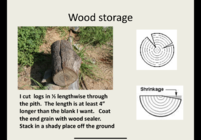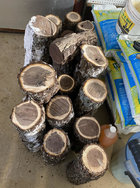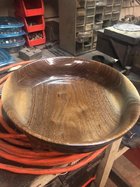-
July 2025 Turning Challenge: Turn a Multi-axis Weed Pot! (click here for details) -
Congratulations to Bobby McCarly for "Hemostatmorphodon" being selected as Turning of the Week for July 7, 2025 (click here for details) -
Welcome new registering member. Your username must be your real First and Last name (for example: John Doe). "Screen names" and "handles" are not allowed and your registration will be deleted if you don't use your real name. Also, do not use all caps nor all lower case.
You are using an out of date browser. It may not display this or other websites correctly.
You should upgrade or use an alternative browser.
You should upgrade or use an alternative browser.
Aquired some free wood today.
- Thread starter Gary Norton
- Start date
- Joined
- Feb 28, 2021
- Messages
- 1,649
- Likes
- 1,440
- Location
- Roulette, PA
- Website
- www.reallyruralwoodworks.com
I'd say, except the pieces you plan to use right off, at the very least put sealer on the ends (may be too late already by now) or take a chainsaw and split them right through the pith (and still, seal the end grain) , assuming you plan to do bowls with them - Some you might rip into slabs and stack with stickers laying flat (and end grain sealed) for spindle turning stock.. Looks like you have a nice collection of Black Walnut.
Some of the smaller diameter pieces, you might try what I did which was to mount whole thing on lathe, bore out the center (pith) and turn hollow forms, (One of them I just made a set of napkin rings - turned away the sapwood, drilled out the pith and turned a nice set of black walnut napkin rings, which did eventually warp a little out of round but not too badly)
Some of the smaller diameter pieces, you might try what I did which was to mount whole thing on lathe, bore out the center (pith) and turn hollow forms, (One of them I just made a set of napkin rings - turned away the sapwood, drilled out the pith and turned a nice set of black walnut napkin rings, which did eventually warp a little out of round but not too badly)
The first thing I do is cut the pith out and then seal the ends. Free wood is a good thing.
Boy what I wouldn't give to live where that's firewood.
Ordered some Anchorseal this morning, I wasn't expecting this wood so it caught me by surprise.
- Joined
- Feb 28, 2021
- Messages
- 1,649
- Likes
- 1,440
- Location
- Roulette, PA
- Website
- www.reallyruralwoodworks.com
'Round here, typically black walnut , the trunk is slabbed, the branches are often not - partly because branches have a far greater amount of stress built into them, so the risks when trying to cut them into boards (and even milling the dried boards) are a bit on the high side, so the branches (some which can often be as much as 2 ft diameter easily) are pretty much just sold away as firewood - also branches often don't have enough "straight" to them to be sawn to lumber...Boy what I wouldn't give to live where that's firewood.
If you haven't tried cutting branch lumber on table saw before, first word of caution: keep an extra pair of undies handy... and make sure you've got a riving knife installed on the saw... When that stress releases (especially on dried lumber) it can sound and feel like a gunshot.. or, it pinches to the riving knife so tightly you can't move the board, have to shut off table saw and hammer a wedge into the kerf to get it off and then re-cut. (hence wanting riving knife in place, if that pinched the back of the blade instead in absence of riving knife, that board is coming back in your face real fast!) You can also experience similar results on case-hardened (improperly dried) lumber
You can use woodworking glue instead of the anchorseal
- Joined
- Apr 27, 2004
- Messages
- 9,234
- Likes
- 5,894
- Location
- Lakeland, Florida
- Website
- www.hockenberywoodturning.com
Consider turning a few NE bowls while the sap ring is still white.
Today!,
Don’t need bark with the sap ring for a great looking bowl.
I like to use blanks 2-4” longer than wide to accentuate the ovalness in the shallow bowls.
Today!,
Don’t need bark with the sap ring for a great looking bowl.
I like to use blanks 2-4” longer than wide to accentuate the ovalness in the shallow bowls.
I would also leave them outside. They have acclimated to the outside weather and if you bring them into a warmer shop, that will build stress, and stress is relieved by cracking.
Wood glue does make a good sealer.
robo hippy
Wood glue does make a good sealer.
robo hippy
Is the wood glue applied directly from the bottle or is it diluted with water?I would also leave them outside. They have acclimated to the outside weather and if you bring them into a warmer shop, that will build stress, and stress is relieved by cracking.
Wood glue does make a good sealer.
robo hippy
Thanks,
It seems to be done both ways. I just put it on full strength. I guess thinning it down will let it soak into the end grain a little better.
robo hippy
robo hippy
- Joined
- Feb 6, 2010
- Messages
- 3,369
- Likes
- 2,431
- Location
- Brandon, MS
- Website
- threeringswoodshop.square.site
With walnut it is no rush to cut the pith out. I have had logs in the pile for 2-4 years with very little cracking
You will enjoy turning the Walnut, one of the easiest woods to turn.
They are in my garage for now, it is heated but I keep the temp at 60 still a 30-degree shift for my area. I did get them end sealed. Amazon actually delivered the Anchorseal the same day that I ordered it, late delivery about 8 pm but still the same day.I would also leave them outside. They have acclimated to the outside weather and if you bring them into a warmer shop, that will build stress, and stress is relieved by cracking.
Wood glue does make a good sealer.
robo hippy
I would still wrap them in tarps. Just the change in 'weather' can cause cracking...
robo hippy
robo hippy
- Joined
- Apr 27, 2004
- Messages
- 9,234
- Likes
- 5,894
- Location
- Lakeland, Florida
- Website
- www.hockenberywoodturning.com
I picked up a bit of fresh cut pecan yesterday. Do I need to cut the pith out of that or just seal the ends?
If it is smaller than 4” diameter good chance it won’t crack if left in the round.
If the logs are in 8 foot lengths they will keep a long time without cracking.. end checking in logs can be as much as 4”.
I get most of my wood in 3-4 foot lengths. The biggest I can handle with my hand truck rounds this long will crack over time even when end sealed.
When wood dries each growth ring shrinks more around ( tangential) than the ring inside it so you get big cracks.
Cut in half through the pith you get a peak on the cut face instead of cracks usually and end checking is usually less than 2”.
A page from the notes I use in working with green wood

Last edited:
I’m offering a hypothesis here that for woods prone to splitting even if you cut it in half (like cherry) that cutting the outside slab off might relieve some of the tension leading to splits at the center. It think I am noticing this helps but only based on a few observations. Anyone else notice/know of this?Cut in half through the pith you get a peak on the cut face instead of cracks usually.
Cutting to one side of the pith a couple inches will help too. (Me thinks)
- Joined
- Apr 27, 2004
- Messages
- 9,234
- Likes
- 5,894
- Location
- Lakeland, Florida
- Website
- www.hockenberywoodturning.com
Some cherry the sapwood wants to move a lot more than the heartwood so cutting off the sapwood would help.I’m offering a hypothesis here that for woods prone to splitting even if you cut it in half (like cherry) that cutting the outside slab off might relieve some of the tension leading to splits at the center. It think I am noticing this helps but only based on a few observations. Anyone else notice/know of this?
Cutting to one side of the pith a couple inches will help too. (Me thinks)
Getting further from the pith is always good. I don’t do it unless the logs are larger diameter than 24 inches.
I do lots of NE so want to keep that option available in the blanks I harvest. Cutting off a slab would ruin the NE.
Thanks for all of the tips.
I buy green wood sealer from Rockler. It is cheaper and if you buy two you get free shipping.Ordered some Anchorseal this morning, I wasn't expecting this wood so it caught me by surprise.


